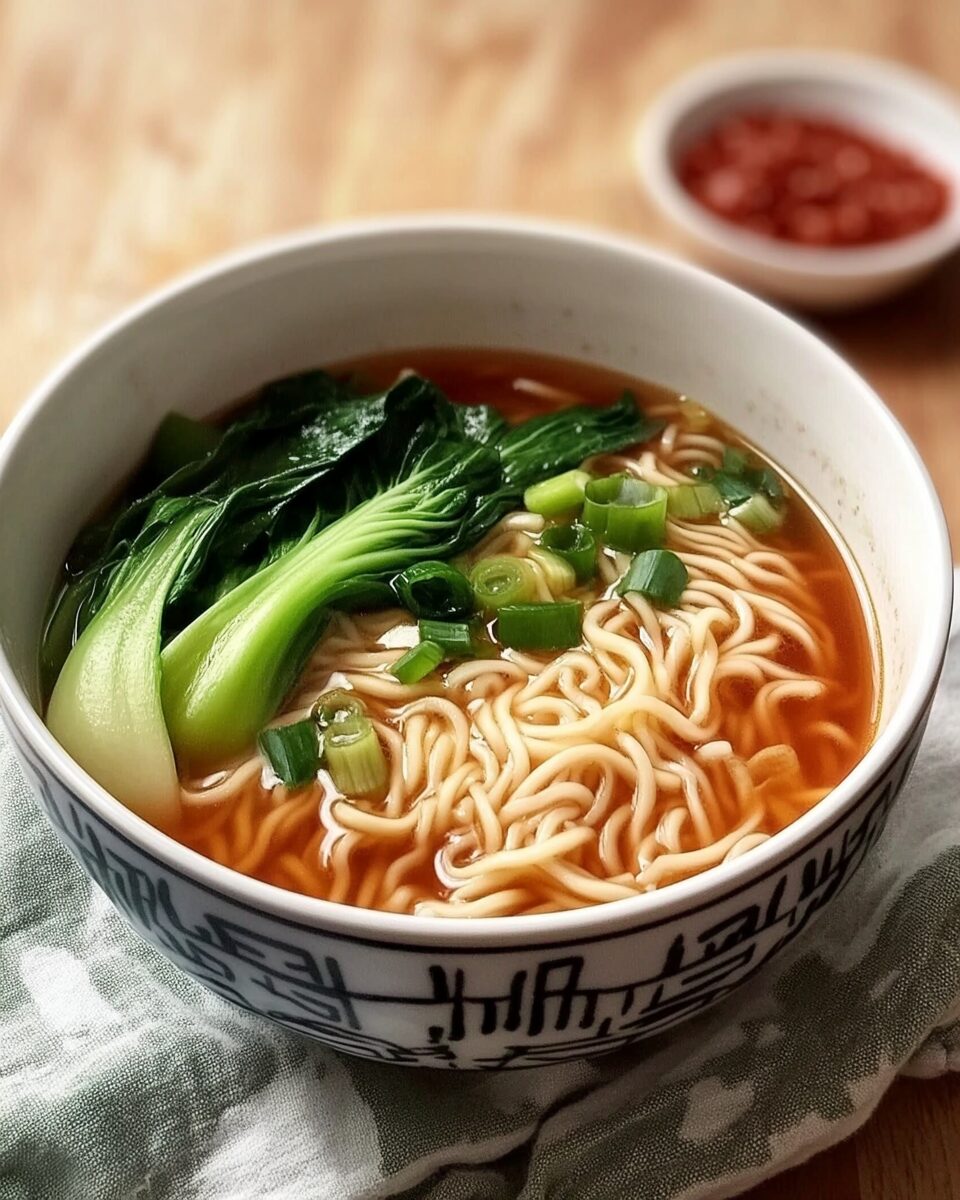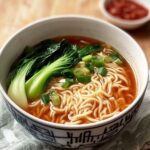Chinese Noodle Soup is a timeless bowl of comfort, combining a fragrant, savory broth with tender chicken and fresh, crunchy vegetables like bok choy and carrots. The silky egg noodles soak up all the flavors, making each bite warm and satisfying.
This soup is perfect for those seeking an easy yet nourishing meal that feels both light and hearty. Whether you’re battling the cold or simply craving something wholesome, this Chinese Noodle Soup is quick to prepare and endlessly adaptable to your preferences — add chili for heat, swap chicken for tofu, or toss in your favorite greens to make it your own.
Full Recipe:
-
200g egg noodles
-
4 cups chicken broth
-
2 cups cooked shredded chicken (or use rotisserie chicken)
-
1 tablespoon soy sauce
-
1 teaspoon sesame oil
-
2 garlic cloves, minced
-
1 teaspoon fresh ginger, grated
-
1 carrot, julienned
-
1 cup baby bok choy, chopped
-
2 green onions, sliced
-
Fresh coriander (cilantro) for garnish
-
Salt and pepper to taste
Directions:
-
Cook egg noodles according to package instructions. Drain and set aside.
-
In a large pot, heat sesame oil over medium heat. Add garlic and ginger and sauté until fragrant, about 1 minute.
-
Pour in chicken broth and bring to a gentle boil.
-
Add soy sauce and shredded chicken to the broth. Simmer for 5 minutes to heat through and meld flavors.
-
Add julienned carrots and bok choy; cook for 3-4 minutes until vegetables are tender but still crisp.
-
Season with salt and pepper to taste.
-
To serve, divide cooked noodles into bowls and ladle hot soup over them.
-
Garnish with sliced green onions and fresh coriander. Serve immediately.
Prep Time: 10 minutes | Cooking Time: 20 minutes | Total Time: 30 minutes
Kcal: 320 kcal | Servings: 4 servings
The History and Origin of Chinese Noodle Soup
Chinese noodle soup is a classic and beloved dish with deep roots in Chinese culinary history. Noodles themselves have been a staple in China for thousands of years, believed to have originated over 4,000 years ago. Over time, these noodles evolved from simple wheat dough strands to include a wide variety of shapes, thicknesses, and cooking methods. The addition of soup, broth, and various proteins transformed the humble noodle into a hearty and flavorful meal that has spread worldwide.
The combination of broth, noodles, and toppings such as chicken or vegetables reflects a fundamental approach in Chinese cooking: balancing flavors, textures, and nutrition. Regional variations are common, with different parts of China emphasizing distinct broths—richer, meatier broths in northern regions and lighter, clear broths in southern areas. This recipe captures the essence of a classic, comforting Chinese noodle soup that’s both approachable and versatile for cooks of all skill levels.
The Nutritional Benefits of Chinese Noodle Soup
Chinese noodle soup is not just delicious but also offers a nourishing and balanced meal option. The broth, typically made from chicken or vegetable stock, is hydrating and packed with minerals that support overall health. The addition of ginger and garlic not only enhances flavor but also brings immune-boosting and anti-inflammatory benefits.
Egg noodles provide carbohydrates for energy, while the chicken contributes lean protein essential for muscle repair and satiety. Vegetables like bok choy and carrots add fiber, vitamins, and antioxidants, making this dish a well-rounded option that satisfies hunger and supports wellness. Compared to heavier or fried meals, Chinese noodle soup is light on the stomach yet fulfilling, making it ideal for any time of day, especially during colder months or when recovering from illness.
The Role of Broth in Chinese Noodle Soup
The broth is the heart of any noodle soup and deserves special attention. It’s what brings all the elements together and provides the characteristic warmth and depth of flavor. In Chinese cuisine, broth is often simmered for hours to extract maximum flavor from bones, herbs, and aromatics. While this recipe uses store-bought or homemade chicken broth for convenience, taking the time to prepare your own broth can elevate the dish to another level.
Key ingredients like ginger and garlic are essential in broth-making because they add subtle heat and complexity. Soy sauce introduces savory umami notes, while sesame oil gives a toasty richness that complements the other flavors. The balance between salty, aromatic, and slightly sweet elements in the broth makes it soothing and satisfying, inviting you to savor every spoonful.
Variations and Customizations
One of the best things about Chinese noodle soup is its flexibility. This recipe can be easily adapted to suit personal tastes, dietary preferences, or ingredient availability. For example, chicken can be replaced with tofu or mushrooms to make a vegetarian version without sacrificing flavor. Different types of noodles such as rice noodles, udon, or soba can be used depending on your preference or what’s on hand.
Vegetables are another area ripe for customization. While bok choy and carrots are classic choices, you can add snap peas, spinach, mushrooms, or even corn to introduce new textures and flavors. Spice lovers might want to include chili flakes or fresh sliced chilies for a warming kick. For an extra burst of freshness, adding a squeeze of lime or a sprinkle of fresh herbs like Thai basil or coriander can brighten the soup right before serving.
Cooking Tips for Perfect Noodle Soup
Making a great bowl of Chinese noodle soup involves a few simple but important techniques. First, cooking the noodles separately ensures they remain firm and don’t become mushy when added to the hot broth. Rinsing them in cold water after cooking can help stop the cooking process and prevent sticking.
When heating the broth, be careful not to boil vigorously once the ingredients are added, especially the vegetables and chicken, as this can toughen the meat and overcook the greens. Instead, keep the soup at a gentle simmer to maintain tenderness and vibrant color.
Seasoning should be done gradually—taste the broth as you add soy sauce, salt, or pepper to avoid over-salting. Lastly, garnishing with fresh herbs and green onions right before serving adds a lovely aroma and visual appeal that makes the dish more inviting.
Serving Suggestions and Pairings
Chinese noodle soup can be a complete meal on its own, but it also pairs wonderfully with a variety of side dishes. Light appetizers such as steamed dumplings, spring rolls, or pickled vegetables complement the flavors without overwhelming the palate. For a heartier meal, a simple stir-fried vegetable or meat dish alongside the soup can add variety and substance.
If you want to keep the meal light and healthy, consider serving with a crisp cucumber salad dressed with sesame oil and rice vinegar or a refreshing mango salad. For drinks, jasmine tea or a mild green tea balances the richness of the broth beautifully.
Cultural Significance and Comfort Food Status
In many Asian households, noodle soup is considered the ultimate comfort food. It’s often associated with care, healing, and family gatherings. A warm bowl of noodle soup can evoke nostalgic memories of home-cooked meals and is frequently served to those feeling under the weather as it’s easy to digest and soothing.
The dish’s cultural significance extends beyond nourishment; it represents warmth, hospitality, and tradition. Making noodle soup from scratch is a way to connect with Chinese culinary heritage, sharing the comforting flavors that have been passed down through generations.
Conclusion
Chinese noodle soup is a timeless and versatile dish that offers both comfort and nutrition in every bowl. Its harmonious blend of savory broth, tender chicken, fresh vegetables, and silky noodles creates a satisfying meal that is perfect for any occasion. Whether you are a novice cook or an experienced chef, this recipe is straightforward enough to prepare quickly but flavorful enough to impress family and friends.
Beyond its taste, this soup carries cultural importance as a comforting, nurturing dish that symbolizes warmth and care. By customizing the ingredients and broth to your liking, you can create your own version of this beloved classic that suits your personal preferences. Serve it on a cold day or when you need a soothing meal — Chinese noodle soup never fails to deliver hearty satisfaction and wholesome nourishment.






